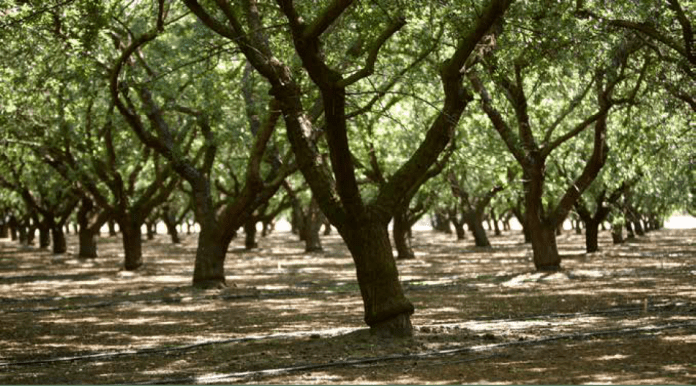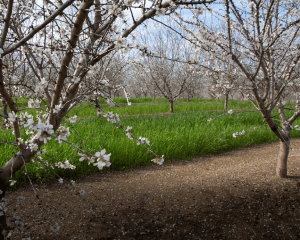
Growers know when you plant a new orchard, you’re making a 25-year bet. There are several risks involved, and the payout is not guaranteed. One way to hedge your bet and make the most of your investment is by choosing the right rootstock. But what is the right rootstock? This question was discussed back in December by a panel of experts during the 50th Annual Almond Conference.
“We are often asked as farm advisors, ‘What’s the best rootstock?’” said Katherine Jarvis-Shean, UCCE orchard systems advisor. “You can’t find all the desired characteristics in one rootstock, so you must know the limitations of your site. In a lean price year like this one, we want to think about how to use rootstock to avoid additional inputs and labor in the future.”
To help individual growers identify the best rootstock for their site conditions, UCCE, with support from the Almond Board of California, recently published a guide titled, Almond Rootstock Comparison Guide. The resource compiles the latest research on existing rootstock varieties to help almond growers compare each variety based on several characteristics including tree vigor, branching, anchorage, nutrient uptake and disease and nematode resistance. The guide can be found online at the Fruit and Nut Research and Information Center’s website. There, growers can find a download to the resource, virtual library of rootstock characteristics and a virtual tool that compares rootstocks similar to when a consumer is comparing electronics before purchase.

Understand Your Shortcomings
During her presentation, Jarvis-Shean advised growers to first identify the shortcomings of their site and then choose a rootstock that can minimize the greatest limitations.
Soil analysis prior to planting can help growers understand the nutrient needs of their orchard and select a rootstock that can help alleviate the effects of surplus or deficient nutrients.
For example, in a site where there is excessive boron, sodium or chloride, the right rootstock could act as a gatekeeper and limit the amount of that nutrient that is taken up by the tree. Jarvis-Shean used an example of a high-sodium site. In the field trials, peach-almond hybrids such as Hansen and Paramount were consistently better at excluding sodium than complex, plum or peach rootstocks. In this case, choosing the right rootstock would mean healthier trees, higher yields, and potentially less effort trying to reduce sodium uptake in the future.
The right rootstock can also maximize the intake of desired nutrients, such as nitrogen and potassium, reducing fertilizer inputs. Jarvis-Shean noted in field trials, peach-almond hybrids generally had higher levels of nitrogen and potassium than peach, but there were some exceptions.
“This research is a first pass at understanding how we could use rootstocks to decrease fertilizer inputs,” Jarvis-Shean explained. “We are still figuring out why certain rootstocks are more efficient than others at making nutrients available. We do know some rootstocks consistently take up higher nutrient values.”
In addition to nutrient management at the site, climatic conditions such as wind may play a significant role in rootstock selection. Rootstocks vary in their ability to anchor trees successfully and show different tolerances in both normal wind and extremely gusty conditions. Within each rootstock category with similar parentage, the performance of the different rootstocks varied dramatically. However, in Stanislaus County field trials, there are two rootstocks that led the pack: Krymsk 86 and Viking. Both rootstocks had the strongest anchorage with fewer trees leaning more than 15%. The importance of growing straight trees goes beyond ensuring trees stay upright. Orchards planted with trees that tolerate wind tend to maintain higher tree densities while experiencing reduced mechanical damage and increased efficiencies during harvest. “Altogether this has the potential to translate into longer orchard lifespan,” said Sebastian Saa, associate director of Agriculture Research at ABC.
Consider Disease Resistant Rootstock
Rootstock selection can be a valuable tool in managing soilborne diseases such as Phytophthora, Armillaria (Oak Root Fungus) and Prunus Replant Disease. These diseases can have varying effects on orchards, and none of the outcomes are good. Phytophthora and Armillaria attack the tree’s vascular tissue, reducing vigor and in some cases killing the entire tree. Prunus Replant Disease suppresses the growth of trees so dramatically that it often necessitates tree removal.
Field trials conducted by researchers at the University of California and USDA-ARS have examined the genetic resistance of rootstock varieties, both experimental and commercial, to soilborne diseases. Here is a summary of their findings:
Available and experimental rootstocks vary widely in susceptibility to Phytophthora.
Peach-almond hybrid rootstocks, such as Empyrean and Titan, are more susceptible to Phytophthora.
Marianna 2624 rootstock offers field-tested tolerance to Armillaria but is not compatible with Nonpareil varieties.
Peach-almond hybrids generally offer greater Prunus Replant Disease tolerance than peach rootstocks and may reduce the need for fumigation in some soils.Anoth
er key component to establishing an orchard is proper planting and management practices that can make your rootstock less susceptible to soilborne diseases.“Eve
n a disease-resistant rootstock, or a semi-resistant rootstock, can become susceptible to disease based on poor management practices,” said Jamie Ott, UCCE orchard crops advisor. “You really want to give your rootstock a chance to do its job for you.”
the case of Phytophthora, where pathogens move easily in water and the disease infects through the roots and crown, growers can greatly reduce the likelihood of infection by reducing water saturation at the crown. This can be achieved by placing the graft union above the soil line when planting and moving the irrigation sources (drip or microsprinklers) away from the trunk of the tree once established.
Choose the Rootstock with More Vigor
If your site has no clear limitations, Roger Duncan, UCCE pomology advisor, urges growers to go with the rootstock that has the highest vigor.
“The most important reason to choose a rootstock is because of the potential problem that you have in your orchard,” Duncan advised. “If you have a salt problem or if you have a nematode problem, the first thing you want to do is choose a rootstock that works well in those conditions. However, if you don’t have any problems, choose a high-vigor rootstock.”
High vigor rootstocks may help growers increase profitability. In UCCE trials, the most vigorous rootstocks are consistently the highest yielding, usually the most yield efficient and produce larger kernels. In a 2022 field trial, the difference between the highest performing rootstock and the lowest performing rootstock was a yield of 1,318 pounds per acre.
“The top producing rootstocks would have brought an extra $10,000 to $11,000 back to the grower per acre compared to the standard Nemaguard over the span of the six harvests we trialed, and more than $15,000 more than the bottom performing rootstock, Lovell” Duncan explained. “You can make a lot of money from planting the right rootstock at the very beginning.”
The research is clear: peach-almond hybrid rootstocks tend to be the most vigorous, peach rootstocks are in the middle and plum or plum hybrids are the least vigorous. The most vigorous rootstocks can offer higher profits with little to no added expense as long as conditions allow, Duncan noted.
“These benefits are free. This is not from applying different water. It’s not from different amounts of nitrogen or potassium. It’s just putting the right tree in the ground.”















